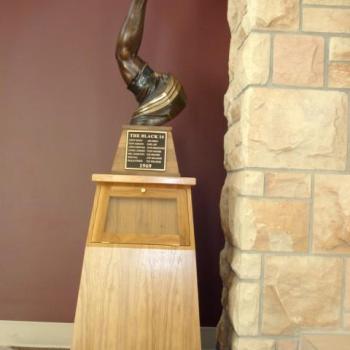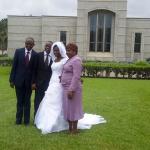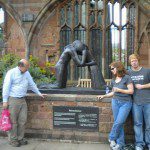I prepared my conference paper with a particular audience in mind—the one I know: Mormons, specifically academic Mormons. The conference was the American Academy of Religion, Seattle, and I (so I thought) would be part of the Mormon contingent. I went to my session with Blair Hodges, who was also set to present. As my readers would expect, I had prepared a presentation on race and Mormonism—specifically what we mean by the recent Church statement, “We condemn racism, including any and all past racism by individuals both inside and outside the Church.”
It was clear to me that more conversation needed to happen about how encompassing the word “racism” was. My friend, the inimitable historian Jim Allen, had suggested at a Mormon History Association meeting that surely the statement indicated that Mormons no longer embraced the “curse of Cain” idea, or the “Blacks did something wrong in the pre-existence” one.
I was certain, however–mostly through anecdotal evidence–that many Latter-day Saints defined racism in ways that excluded them from indictment, even if they still clung to old ideas. Racists might lynch, might use the “n” word, might segregate, but “we” don’t do that. That would be racist. But the “curse of Cain”? Well, didn’t God ordain that?
I periodically look at a particular website to measure church statements, waiting for a time when the site will have to be dismantled because it is no longer consistent with current Mormon teachings. I fully believe that day is near. But it hasn’t come yet. So, on May 5th, I was at AAR to further the conversation. I was ready to talk about what BYU Religion professor Randy Bott had said in 2012—quoted by Jason Horowitz in the Washington Post:
“God has always been discriminatory” when it comes to whom he grants the authority of the priesthood, says Bott, the BYU theologian. He quotes Mormon scripture that states that the Lord gives to people “all that he seeth fit.” Bott compares blacks with a young child prematurely asking for the keys to her father’s car, and explains that similarly until 1978, the Lord determined that blacks were not yet ready for the priesthood.
The Mormons from other universities would understand the context. Perhaps they would smile dimly and shake their heads at the familiar foolishness.
It wasn’t until two speakers had given their presentations that I realized I was in the wrong session. I was not with other Mormons. I was in a section called “Religion and Ethics.” The other presenters and most audience members would not know LDS history, and they certainly would not be conversant with “Bott-gate.”
I had prepared an amusing alternate history, imagining that Joseph Smith’s evolved views of race had undergone further evolution rather than being sent into reverse with Brigham Young’s declaration that “If no prophet has said it before, I say it: The seed of Cain are not entitled to the priesthood.” (See here for more information.) I had expected that my audience would chuckle at the “what might have been” scenarios:
Jane James and her children stay in the Church. Jane becomes a counselor in the General Primary Association and all LDS children learn “This Little Light of Mine.” (Jane’s last Mormon descendant left the Church in 1980. She refused to go to the temple, saying, “I’m the same today as I was yesterday.”
Green Flake becomes a counselor to the mission president in Idaho. (He was described by Idaho Mormon Oz Call as “the best damn missionary we have.”)
Q. Walker Lewis starts schools for disadvantaged children of all ethnicities.
Samuel and Amanda Chambers, with their superior knowledge of berry cultivation, supervise Church welfare in Salt Lake City
In the 1960s, Utah is celebrated as the only state in the nation which does not practice segregation, and the NAACP gives the governor a bouquet of wildflowers.
When it was clear that my audience had no idea who these people were, I skipped ahead to recent statements, several responding to this post by Joanna Brooks. . I read the first comment:
It’s a difficult differentiation to split the hairs between a racist practice and a bigoted practice, just the same as it is difficult to discuss gender differentiation without appearing sexist.
When the Savior initially refuses to bless the Canaanite woman because his mission is to the Jews and not the Gentiles – one could take this doctrine to be racist in that it divides the human family into classes.
In my understanding, the practice of not ordaining negros to the priesthood was a spiritual impression given to Joseph Smith when he was about to perform an ordination similar to others that he had done before.
[sic]
I knew that the audience I had anticipated would perhaps have rolled their eyes. The audience I got dropped their jaws. I heard groans of disbelief and amazement. Clearly, the errant justification was unthinkable, even contemptible to these non-Mormon scholars. They didn’t know that this kind of thing had been freely taught for years after Joseph Smith’s death.
I read another comment:
The question remains, why would God institute such a policy. My theory is that the LDS Church, in its infancy, could have been easily overwhelmed by the issues of the post Civil War. Had Mormons been as ‘enlightened then’ as we believe ourselves to be now, a rapid influx might have overwhelmed the church in a way that the imperfect individuals called to lead and direct may not have been prepared for.
[sic]
Again, my audience was aghast. So there I was, speaking from inside my own bubble and realizing how horrific the words were.
Of course, it got worse. The panel finished and a brilliant woman approached me, waiting politely until I was free to talk.
“What are you going to do?” she asked me. “What are you going to do about this?”
In my mind a vision of the Church hierarchy (Correlation included) spread out. How could I explain that the LDS belief in a modern prophet often prevents needed statements lest they challenge the faith of the feeble? How could I tell her that we as a Church are afraid of speaking boldly about a prophet making a huge mistake, because the prophetic mantle immediately comes into question?
I told this woman that I didn’t know what to do, but that Darius Gray and I had made a documentary which we hoped would help. I could feel myself shrinking as she dismissed the idea with a sympathetic shake of her head.
“A documentary won’t solve this. You will need to take down the whole structure and start over.”
I accepted her card, went to lunch (alone) and sat pondering what she had said.
In my presentation, I had quoted Judgment at Nuremberg, where former Nazi judge Ernst Janning tries to explain his actions to the American judge. In the trial itself, the court had been shown gruesome footage from the Holocaust. Herr Janning says to his judge, “Those pictures, those terrible pictures. You must understand, I never imagined it would come to that.” The American judge responds, “Herr Janning, it came to that the first time you sentenced to death a man you knew to be innocent.”
Indeed, our actions foreordain (set into order) the consequences unless we return to the spot where we took that first step, either for the good or for the bad. Yes, she was absolutely right. We had to undo as much of the damage as possible. We had to repent.
I read her words when I returned home—words from her own endeavor to use scriptural pleas and prayer to lament our common guilt and begin healing.
She, Kathryn Rickert, says:
We can learn how to rejoice and how to weep together…Scripture…is abundant with laments in both poetic and narrative forms[.] Romans 8: 26: ‘Likewise the Spirit helps us in our weakness; for we do not know how to pray as we ought, but that very Spirit intercedes with sighs too deep for words.’We live in a time where this daring prayer is very gradually making a comeback as a fundamental part of the Christian tradition of prayer and worship. The absolute necessity of this kind of prayer is denied, though, when we cannot hear lament as a profound demonstration of love and trust; of opening up to God and to each other.
I returned home sobered by the heights of the spiritual mountains we Latter-day Saints must climb if we are to be one in Christ.
Today, friends let me know that a fellow blogger had posted a ghoulish photo of a double lynching on the Mormon channel of Patheos. He intended it to be humorous and as “horrific” as the accusation that Mormons help only other Mormons. I will not post the picture, which was soon replaced by something relevant to what the author was saying. But to him and anyone else who thinks there’s one particle of humor in a lynching, let me say this: DON’T YOU EVER MOCK THE CREATIONS OF GOD, AND DON’T YOU FOR ONE MOMENT MINIMIZE CRIMES AGAINST HUMANITY. Pictures of lynchings etc. should astound us and call us to repentance. They are never punch lines or effective illustrations of “amusing” hyperboles.
I am reminded of a white person in Florida who asked Darius Gray after a fireside, “Why do ya’ll get offended by the word nigger? It’s what we’ve always called you. We don’t mean nothin’ by it.”
Those of us present were stunned for a moment. Darius was diplomatic. I said nothing, except in my mind. There, I said, “Well, Ma’am, your intentions don’t cover your insensitivity, do they.”
On June 8th, the LDS Church will celebrate 35 years since the priesthood revelation, the day that finally returned the priesthood and all its concomitant blessings to those of African descent. I do not represent the church, only myself. But I will be using that day as a day of lamentation and hope. I will read scriptures that teach me how to mourn and how to transform mourning into hope.













